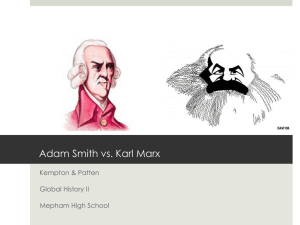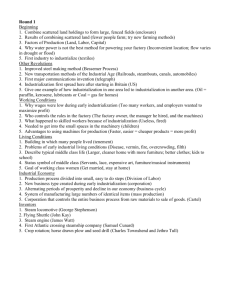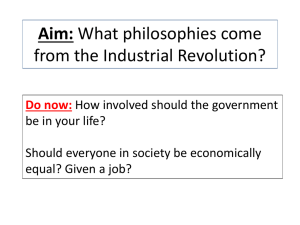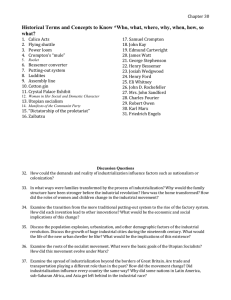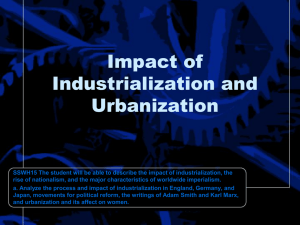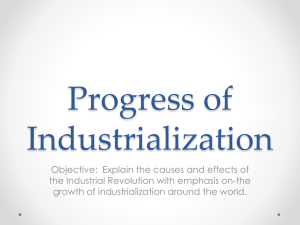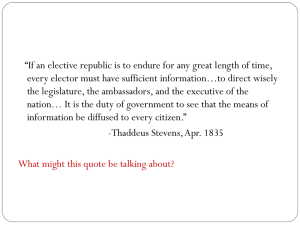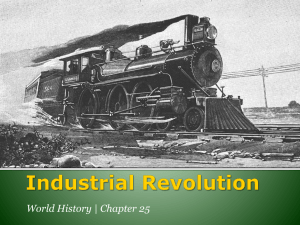13 Industrial Revolution
advertisement
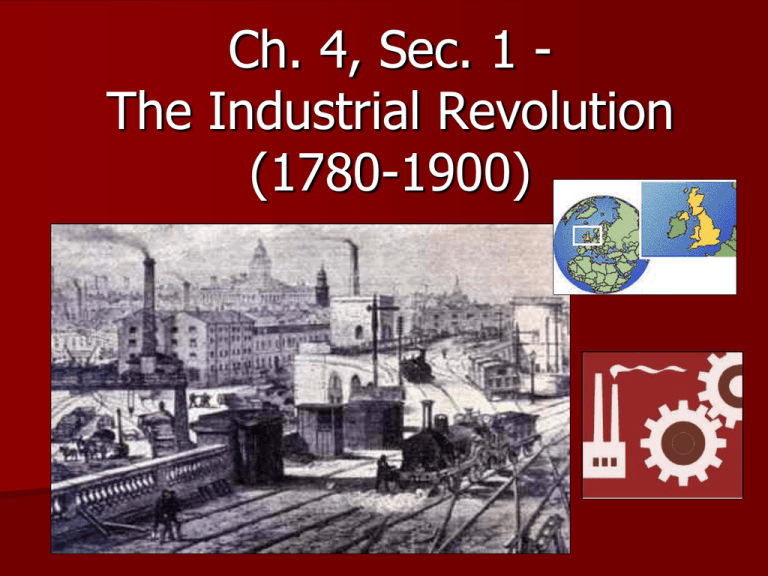
Ch. 4, Sec. 1 The Industrial Revolution (1780-1900) A. Agriculture. 1. Enclosure movement – large landowners bought small farms & applied scientific approach to farming. 2. Used crop rotation & selective breeding by scientific farmers. Jethro Tull was one of the first scientific farmers. This 1836 enclosure map of Hardwick, England, also shows the Toft fields enclosed in 1812 Livestock breeding – only the best sheep allowed to breed; increased average weight from 18 lbs. up to 50 lbs. B. 1. 2. Effects of Agricultural Improvement. ↑ population led to ↑ demand for food & goods. As farmers lost land to enclosures, they left rural villages & moved to the cities to work in factories. C. Industrial Revolution – ↑ output of machine-made goods that began in England in 1780. Coalbrookdale by Night, painted by Philippe Loutherbourg, 1808. D. Why start in England? 1. Many workers. 2. Many natural resources. a) water power & coal. b) iron ore, tools, & buildings. c) rivers & harbors. 3. Strong economy. 4. Business investments. 5. Strong banks. No wars fought in Eng; 6. Political stability. ← military success; and positive attitude. 7. “Factors of Production” – labor, entrepreneurs, land, & capital ($). FACTORS OF PRODUCTIONS E. Machines replaced human & animal power; new sources of power (steam); new raw materials (coal); new mode of production (factory system). Before and After Industrialization Before After Before After Before After Before After F. Textile Industry. 1. Cottage Industry – weaving thread in rural cottages. 2. Industrialization began in textile industry (demand for cotton). Arkwright invented the Waterframe (increased production of textiles) in 1769. Hargreaves’ Spinning Jenny in 1764. G. Eli Whitney & The Cotton Gin. 1. 1793, while working on a GA plantation. 2. Negative impact: ↑ demand for both land & slaves due to profits of cotton. H. Transportation Revolution. 1.James Watt – steam engine in 1765. a) Steam was a cheap, convenient source of power. Robert Fulton’s steamboat provided fast, easy transportation of both raw materials and finished goods. I. 1. 2. 3. 4. Effect of the Railroads: Gave manufacturers a cheap way to transport goods & raw materials. Created new jobs for RR workers, construction, & miners. ↑ agricultural & fishing. Travel for pleasure & work. English train in The mid-1840’s. Economic Changes Railways cut the cost of transporting goods Social Changes: Growth of Industrialization in England 1704-1911 J. 1. 2. 3. Factory Life. New machines were large & expensive; factories built to house machines. Near power sources. People moved to cities to work in factories. The Bessemer Process The Bessemer process was the first inexpensive industrial process for the mass-production of steel from molten pig iron. The process is named after its inventor, Henry Bessemer, who took out a patent on the process in 1855. A Bessemer converter in Station Square, Pittsburgh, PA. K. Negatives of Industrialization. 1. Misery of working classes & urban poor. 2. Time & factory discipline. 3. Ended community villages. 4. Problems from overcrowding (diseases). Cholera ► Solutions = Charity, police, ideology, revolution, urban "renewal." L. Positives of Industrialization. 1. Better diets & housing, cheaper (mass-produced) clothing. 2. Better education. 3. Laborers got better wages, working conditions, & shorter hours (Labor Unions). ► Long term effects can still be seen today. ► Working conditions greatly improved since the 19th Century. Working Poor Typical Coal Miners: Child Laborers: Women Worked in factories Tenement Housing: Child Laborers 1843 English cartoon on the exploitation of children in the mines. M. Class structure. 1. Capitalism – economic system based on private ownership & manufacturing. a) Upper class – owners. b) Middle class – skilled workers, professionals, lawyers, & doctors. c) Working class – laborers, work 12-16 hours/day, 6 days/week, 30 min. lunch & dinner, low wages, fired anytime. The Wealth of Nations by Adam Smith Wealth of Nations (1776) was first modern work on economics. 3 Laws of Capitalism: -- Self interest -- Supply & demand -- Free market (competition) Adam Smith 2. Socialism – society owns the means of production. a) Karl Marx – wrote the Communist Manifesto (1848). i. Public ownership. ii. Classless society. Karl Marx, father of Communism and 19th century philosopher. Karl Marx (1818 – 1883) was a 19th century philosopher, political economist, & revolutionary. Communist Manifesto (1848): “The history of all hitherto existing society is the history of class struggles.” Marx is the co-founder of Marxism (with Engels) and is often called the father of communism. Memorial to Karl Marx in Moscow. The inscription reads “Proletarians of all countries unite!” Marx believed that capitalism would be displaced by communism, a classless society. Marx argued that the analysis of capitalism revealed that the contradictions within capitalism would bring about its own end, giving way to communism. Marx influenced Lenin, Stalin, Trotsky, Mao Zedong, Fidel Castro, Che Guevara, and many others. COMPARING IDEOLOGIES Liberalism Socialism (Democracy) (Communism/ Marxism) Nationalism Conservatism civil property common tradition, liberties, and institutions, social distribution traditions, religious stability, of wealth language, tolerance, obedience to are subject customs uses a political to control constitution by the authority community Diego Rivera mural showing the struggle of the classes. Palacio National, Mexico City. Images of the Industrial Era in Great Britain N. The Continent catches up, 1850-1900. ► England leads between 1780-1850, and then Industrialization spreads to Western Europe after 1850. Question: Why did Germany, and not France, become the industrial leader on the continent after 1850? SPREAD OF RAILWAYS IN TEN SELECTED COUNTRIES [Length of line open in kilometers (1 km = 5/8 mile)] 60000 50000 40000 30000 20000 10000 0 1840 1860 1880 1900 Aust-Hung Belgium France Germany England Italy Holland Russia Spain Sweden Population between 1800 and 1850: Naples grew 5% Moscow grew 32% Paris grew 93% London grew 140% Leeds grew 1260% O. 1. 2. 3. Industrialization Spreads 1789, Samuel Slater emigrates illegally to U.S. Builds spinning machine from memory. 1790, 1st textile factory opens in U.S. Lowell Textile Mills, 1813 Lowell Mill Girls P. Rise of Global Inequality. 1. Industrialization leads to Imperialism: a) Widened gap b/w industrialized & non-industrialized countries. b) Need steady supply of raw materials. c) Exploitation of overseas colonies for materials & markets.
